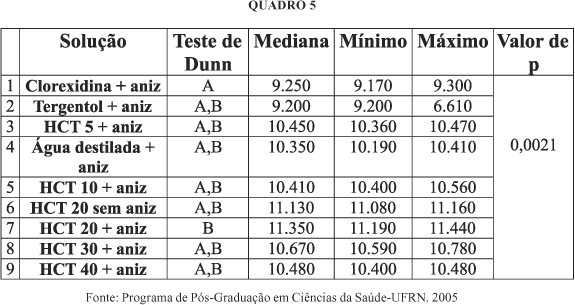PURPOSES: This research desenvolved in Rio Grande do Norte Federal University, Department of Dentistry purpose evaluation "in vitro" Ca(OH)2 and tergentol solutions action in oral cavity that first reside in and cariogenic microorganisms for dental biofilm chemical control increasing. METHODS: "In vitro" tests with antibiogram discs and biofilm formers bacteria antibiothic action from Ca(OH)2 and tergentol solutions and the 0,12% clorhexydine digluconate as "gold-standard". RESULTS: The results were analyzed using the Kruskal-Wallis test and Dunn´s multiple comparison post-test with p-value always lower than 0,05. The clorhexydine showed a better antimibrobian action in correlation with Ca(OH)2 and tergentol solutions. The statistical differences among clorhexydine and this study other solutions was not significant in a greater part of comparisons. CONCLUSIONS: The 0,12% clorhexydine digluconate was the most effective antibiotic agent in this research. Ca(OH)2 and tergentol solutions does not demonstrate satisfactory effectiveness in correlation the clorhexydine, mainly, for the Streptococcus mutans. More complete studies are necessary for CHD 20 evaluation as an oral antiseptic.
Calcium hydroxide; CHD 20; Chemical control





